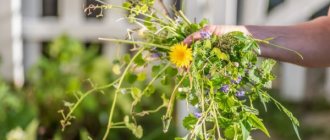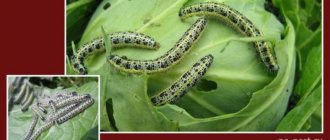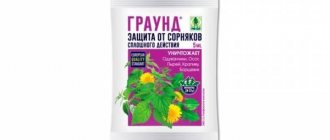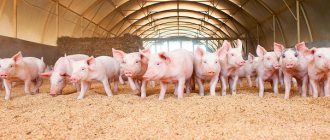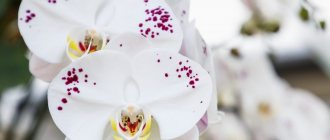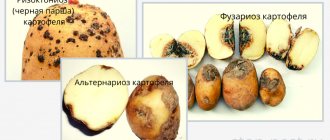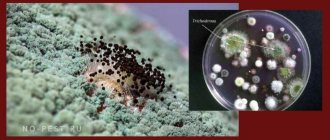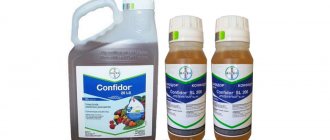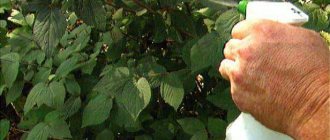Safety and toxicity
Glyphosate belongs to the 3rd class of hazard substances, due to the fact that its contact with the skin can cause skin cancer; when working with the drug, you should strictly use a full set of personal protective equipment with a gas mask, both in large quantities over large areas and in procedure for weed control in small areas.
The harm to humans from glyphosate is not limited to the immediate effects. The persistent carcinogenicity of this substance in nature makes the long-term consequences of its use, which are still terrifying, even more terrible. Glyphosate is otherwise called a weapon of mass destruction of people and livestock.
Scientists have come up with a means to destroy agricultural pests, but it turned out that they not only kill weeds, but also have a very detrimental effect on humans. There is even such a thing as farmer's disease, which is common among gardeners and gardeners who use toxic glyphosate on their plots.
The remains of this substance in nature move with water and enter the human body. Even in pregnant women who have never been exposed to glyphosate, it causes genetic abnormalities in the fetus.
Glyphosate is toxic to humans
Also, this substance causes such severe and irreversible diseases as:
- infertility in men and women;
- the birth of children with genetic mutations (hermaphroditism, dwarfism, dementia);
- hormonal imbalance in children during puberty;
- tumor formation;
- severe eye irritation;
- birth of children with autism;
- liver disease, kidney disease.
Every year, farmers spray millions of liters of glyphosate onto their fields, poisoning humanity for years to come. Some EU countries are planning to phase out this chemical in the near future. A number of retail chains have removed gardening products containing glyphosate and products grown using the drug from their shelves.
Five countries have banned the use of glyphosate in their country:
Chinese manufacturers produce the most glyphosate – 70% of all products.
The only way out is not to buy fruits and vegetables grown by farmers. But city dwellers who do not have their own vegetable gardens are forced to purchase them at risk to their health.
Advantages and disadvantages of the herbicide "Glyphos"
Each chemical has its own advantages and disadvantages. For the herbicide in question "Glyphos" the advantages are:
- within a short time the expected result is achieved, from 3...5 to 15...20 days will be needed to clear the area of weeds;
- The presence of surfactants in the composition promotes rapid absorption of the active substance by the plant. After 35...50 minutes, more than 75% of the dispersed drug is absorbed;
- even if it rains after 3 hours, the absorption of the drug has already occurred. Therefore, it is recommended to use it in cloudy weather;
- the drug is resistant to ultraviolet radiation;
- when performing treatment, you can combine the chemical with other pesticides;
- the herbicide does not accumulate in the soil. After cultivation and decay of vegetation, the soil remains clean;
- the chemical breaks down into its components, the content of phosphate compounds (phosphorus fertilizers), which are used by cultivated plants, increases;
- The guaranteed shelf life is 5 years. In reality, the chemical retains the ability to act on weeds for a longer time.
The disadvantages of Glyphos include the following:
- If during processing you do not follow safety precautions for working with toxic substances, you can get poisoning characterized by nausea and vomiting. The work can be performed using personal protective equipment. The presence of other people, and especially children, is unacceptable;
- The effectiveness of the chemical is observed only upon contact with the green parts of plants. It is not absorbed from the soil surface. Therefore, it is necessary to spray and place the sprayer at a height above 0.8...0.9 m;
- when spraying the drug during processing, you should remember that the smallest particles scatter at a distance of 3...4 from the spray nozzle;
- the prepared solution remains effective for 6...8 hours. Further in the water, the saturation of the main component decreases. It's falling apart.
Read also: Caring for blackberries in the fall, preparing for winter
Application benefits
When starting to use Glyphosate, not all gardeners pay attention to the negative aspects of use. The effectiveness of the drug - these are the indicators for purchasing and cultivating your land
Therefore, it is worth paying special attention to the positive and negative aspects. Especially if there are perennial cereals and dicotyledonous plants in the garden
| pros | Minuses |
| Leaves no traces in the lower layers of the soil. Therefore, it is allowed to use before sowing and until young sprouts appear. | 5% – damage to human blood cells when ingested |
| Small amount of consumption to create a working solution. High efficiency | 2% – can damage DNA chromosomal aberrations |
| You can use mixing if necessary. But herbicides must have a 2.4 D base | There is a risk of lymphoma (non-Hodgkin's) |
| Third toxicity class. Does not pose a threat to people or animals when sprayed. Does not harm pollinators | |
| Ground pollination method. For large areas - aerial spraying |
Representatives of the manufacturer’s company are trying to refute the negative aspects in court. In the territory of the post-Soviet space, Glyphosate is not prohibited from being used.
Dosage calculation and consumption rate
The working fluid is calculated strictly according to the recommendations in the instructions. Each type of herbicide proposed above has its own dosage for application. The only thing they have in common is that the drug is highly soluble in water.
Can be used for both annual and perennial plants. Consumption rates differ not only by age, but also by type:
| Species and age | Preparations and norms |
| Annual plants | 1 list: Glyphos and Fighter, Ground and Roundup are used per bucket. Added dose – 80 ml. But list 2 is small: Chistograd is diluted differently: 3 liters + 50 ml of the substance. Product consumption: 5-10 liters per 100 sq. m. |
| Perennial crops | Increasing doses is mandatory. First list: the amount of water is the same. Add 120 ml of substances. Second list: the same amount of water. Substances – 75 ml. |
| Trees and shrubs | Without dilution, the drug is poured into the nicks. The distance is 5 cm. There is no single norm. If the tree is old, then it is recommended to pour more substances |
Interesting Facts
- According to Professor Charles Benbrook, glyphosate is the most widely used herbicide in the world.
- Glyphosate has been used in the fight against narcotic substances. With the help of this herbicide, coca crops were controlled in Colombia.
- The first time we learned about the new glyphosate drug was in 1970. Then the international company Monsanto patented the invention until 2000. The first continuous herbicide was Roundup. After the patent expired, other crop protection companies began releasing their own versions.
- The name "Roundup" refers to the circle of wagons through which the Americans shot at the Indians.
- In 1987, the person who discovered this compound received a National Medal.
Glyphosate kills all weeds. The soil for winter crops is prepared using glyphosate preparations in August-September, and for spring crops it is possible both in the fall and in the spring, before sowing or before germination. Glyphosate can be used as a desiccant. With a no-till system, the soil is not treated with traditional plowing or minimum tillage.
Mechanical treatment prevents the appearance of weeds. Soil that has not been mechanically treated needs to be treated with glyphosates, otherwise the plot of land will become overgrown with weeds. When cultivating the soil, you should follow the application instructions in order to get the result you need.
Tilling the land correctly is an art. When I worked as an agronomist, we were able to destroy persistent wheatgrass only with the help of glyphosate treatment. Such drugs have advantages and disadvantages, choose what is right for you.
Reviews on the use of the herbicide "Glyphos"
Alexander Krutikov (36 years old, entrepreneur, Gorno-Altaisk)
I decided to build a country house near Katun. Thickets of weeds made it difficult not only to build, but also to examine the site. I asked the workers to treat the area with Glyphos. After 20 days, not a single weed remained. All the weeds were destroyed.
I was pleasantly surprised that the plot turned out to be exactly what my wife and I wanted. Two years have passed. We have now moved to a new house. My wife likes to work in the garden and flower bed. If weeds appear, we quickly get rid of them using the herbicide Glyphos.
Anna Aleksandrovna Stepashkina (56 years old, pensioner, Samara)
At the summer cottage, which I inherited from my grandfather, weeds were always rampant. The nettle did not allow passage, the wormwood could not be removed.
After retirement, I live in the country from April to October. I immediately decided that I needed to fight the weeds. For three years, every spring I sprayed with Glyphos. Now I rarely even take a hoe. Small weeds appear, but I can easily eliminate them. I haven’t seen large bushes of wormwood and nettle for a long time.
I'll tell you a secret, my neighbors have a lot of weeds. They are trying to fight with old-fashioned methods, but it doesn’t help much. But they don’t even want to hear about chemistry. Everyone chooses their own methods of struggle. I decided to trust the chemists and I don’t regret it.
Vladimir Anatolyevich Khramov (48 years old, retired combat veteran, Tver region)
I live mostly outside the city. I need air. That's why I spend a lot of time outside the house. It’s difficult to take care of the vegetation; I ride in a wheelchair. To ensure that the area always remains free of weeds, the wife regularly applies chemicals.
Read also: What to grow seedlings in? Choosing containers for seedlings, which ones are best suited for growing seedlings
For more than ten years we have not had a single allergen; previously, in July-August, wheatgrass pollen prevented us from breathing. We also help our neighbors get rid of this weed. I don't have to go for a walk wearing a gauze bandage.
Of all types of herbicides, we give preference to Glyphos. This drug fights weeds best of all. In ten days it destroys all weeds.
We recently worked on the lawn. Before sowing the lawn grass, the area was sprayed. The wife sowed grass. Now I spend more time there. The grass is short and a pleasure to ride on.
Antonina Sergeevna Vyatkina (72 years old, pensioner, Rostov region)
Ambrosia has tormented me. Every summer this grass grows not only on my site. I came up with a proposal to combat this allergen. The head of our village administration supported me. Now the entire village is being controlled using the herbicide Glyphos.
Precautionary measures
The main question for the farmer was: is glyphosate harmful to humans? Still open. Despite the low toxicity (hazard class 3), recent studies show adverse effects on the human body. This is not to say that the drug affects everyone unfavorably.
But recent experiments have shown: 8-9% of people who used Glyphosate have health problems. It is difficult to say whether they were provoked precisely by the main ingredients.
Some countries have imposed a moratorium on use. But in the post-Soviet countries it is allowed. At the same time, experts strongly recommend remembering: it is better to comply with the protection conditions.
Glyphosate is an irreplaceable thing in the household. Only he will help remove the remnants of the harvested crop and weeds.
It is important that in this way plants are protected from fungi and parasitic microorganisms. After all, the drug actively fights fungal spores and other diseases that are located on the soil surface
How to prepare the solution
In order to destroy weeds on 1 acre of land, you will need 5 liters of diluted preparation. Glyphos is bred taking into account the weed variety:
- To destroy dicotyledonous and annual cereal weeds, you need to dilute 80 ml of the product in 10 liters of water.
- Dicotyledonous cereal perennials require the application of more poison, as they have a more powerful root system. So, you will need 120 ml of Glyphos per 10 liters of water.
So, in order to quickly and effortlessly deal with weeds, you need to strictly follow the recommendations given in the article and the instructions for the drug. Remember that Glyphos is a strong, continuous substance, so it is best to use it before planting crops.
We also invite you to watch an overview video about Glyphos:
Instructions for use of Glyfor against weeds, description of the herbicide and consumption rates
The use of herbicides is justified by several arguments. There is no need for monotonous weeding of beds. The effect of the drug is longer than the mechanical destruction of unwanted guests. The product is equally effective for both perennial and annual pests. Meet: detailed instructions on the doses and use of Glyfor against weeds.
Composition, formulation and purpose of the herbicide Glyfor
The drug contains glyphosate, a complex, universal action product. It is available in liquid form; all you have to do is dilute it with water in the required concentration.
Glyfor copes with a wide range of pests:
- Annuals.
- Perennial.
- Cereals.
- Dicotyledonous.
- Dandelions.
- Convolvulus.
- Birch.
- Sow thistle.
By using Glyfor, you can be sure that the weeds will be gone from the area for a long time.
Mechanism of action and speed of action
The effect of Glyfor is based on the following factors: the drug interrupts the development of amino acids in harmful plants, while simultaneously changing the permeability of membranes in cells. These circumstances have a depressing effect on the viability of weeds; they die before our eyes. As a rule, within 3-4 days for annual pests and 10 for perennial pests, the leaves wither and the aerial parts dry out.
How long does it protect?
On average, the drug retains a high concentration in plant tissues for almost 2 months, up to 50 days. All this time there is intensive pumping from the above-ground part of the weed to the underground. With standard processing, mechanical destruction, it is the roots hidden in the depths that pose the greatest danger. The herbicide eliminates this problem once and for all.
Advantages and disadvantages
To ensure the reliability and high efficiency of the product, consider its advantages:
- It affects all parts of the plant, equally inhibiting leaves, stems, and roots.
- Recommended for a wide range of garden pests.
- It is not washed out of the weed tissue even in the rain.
- Decomposition in the soil occurs quickly; traces of the chemical do not penetrate into cultivated plants.
- Already 7 days after the dressing, sowing of seeds and planting of seedlings is allowed.
- By type of action it is classified as a desiccant - a substance that inhibits the underground part of the weed.
- The shelf life is 5 years.
Among the shortcomings, one can highlight one, but a serious one: Glyfor is a herbicide, a poison that poses a danger to humans
Handling it requires precautions
Consumption measures for different plants
Depending on the type of crop, the concentration of the plant treatment agent varies. Spring crops, potatoes, and vegetables must be sprayed according to the following scheme: 80 milliliters of Glyfor for annuals and 100 milliliters for perennial weeds. The dose of the drug is diluted in a bucket (10 liters) of water.
Gardens and vineyards are treated according to a similar principle: they are sprayed in the summer at the rate of 80/120 milliliters for annual/perennial pests. The same is done with areas that are planned to be prepared for sowing next year (or after harvest).
How to properly prepare and use the working solution
The mixture is prepared immediately before use. If there are cultivated plants near the treatment area, it is advisable to cover them with film and isolate them during spraying. The required dose of the product, depending on the etching scheme, is diluted in a bucket of water.
Spraying occurs optimally quickly and reliably using a garden sprayer. Only the green parts (stem, leaves) are processed; there is no need to water the roots. The prepared Glyfor solution is not intended for long-term storage; it should be used as quickly as possible.
Precautions when working with the product
Glyfor belongs to hazard class 3 (moderate). Translated into Russian, this means that it is difficult to get poisoned by the drug, but it is also not advisable to allow it to get into the organs of vision, the esophagus, or the mucous membranes. In this case, it is necessary to immediately rinse the affected organ or area with warm water.
If swallowed, induce vomiting or consult a doctor immediately. When performing spraying, use special clothing, rubber gloves and a mask, as well as safety glasses.
Security measures
The drug is used in protective equipment: overalls, gloves and a respirator. Before work, you need to make sure that there are no pregnant or nursing women, children or animals nearby. People prone to allergies should not use the product.
Expert opinion
Zarechny Maxim Valerievich
Agronomist with 12 years of experience. Our best country expert.
Ask a Question
If the chemical gets on the skin or mucous membranes, wash the area with plenty of water. If allergic reactions or burning occur, you should immediately consult a doctor.
GLYFOR, VR (360g/l)
| Company manufacturer | Processed crop | Packaging l/kg | Consumption rate kg, l/ha | Price |
| KCHHK | Continuous action | 20l | 2,0-4,0 | to know |
- Manufacturer: Kirovo-Chepetsk Chemical Company
- Preparative form: aqueous solution (VR)
- Active ingredient: glyphosate (isopropylamine salt)
- Active concentration: 360 g/l glyphosate content
- Chemical class of active substance: glycine derivatives
- Packaging: 20l canister
A general exterminating herbicide for the control of harmful vegetation in agriculture, forestry and public utilities.
Peculiarities
- High-tech systemic herbicide with continuous action. Desiccant.
- Fast action and high reliability.
- Almost complete destruction of all types of weeds.
- Use in both spring and autumn.
- It is not washed off by precipitation 2-3 hours after spraying.
- Sowing of crops is possible from 2 - 5 days to 2 weeks after treatment.
- Rapid decomposition in the soil, no residues in the crop.
- Compatible with most pesticides used.
- Convenience and ease of use, safety for personnel.
Purpose
A general exterminating herbicide for the control of harmful vegetation in agriculture, forestry and public utilities.
Desiccant, i.e. a preparation intended for drying standing plants.
Impact speed
The effect of the drug becomes noticeable on annual weeds after 2-4 days, on perennials - after 10 or more days. Signs of the drug’s action are gradual wilting, yellowing, and then browning of the leaves.
Compatibility with other pesticides
The drug is compatible with 2,4-D (in the form of ester), not compatible with highly alkaline drugs.
Before using in mixture with other chemical protection products, it is recommended to check for compatibility.
Mechanism of action
Glyfor blocks the synthesis of aromatic amino acids and affects the permeability of cell membranes, which leads to a change in osmotic pressure and, ultimately, to the destruction of cellular structures. It has a systemic effect and is able to move throughout the plant, getting from the above-ground part to the roots. It is used in fields intended for sowing corn, spring grain and vegetable crops, etc. It is also used for pre-harvest treatment of grain crops to dry the grain and partially suppress the growth of weeds.
What is Glyphosate, herbicides based on it against weeds, the pros and cons of the drug
Destruction of weeds mechanically requires a lot of time and effort. A modern approach to the problem has made it possible to develop special agrochemicals that, in one application, can destroy harmful wild plants on a plot of any area. One of the first to use the herbicide Glyphosate against any weeds. This drug is popular all over the world; today, many agricultural products with similar effects have been developed based on it. But, like any chemical, Glyphosate has its own characteristics that should be taken into account when choosing a suitable herbicide.
Chemical characteristics and purpose of Glyphosate
Glyphosate appeared in the middle of the last century thanks to the work of American biochemist John Franz. It was he who determined the herbicidal effect of the substance on plants. The patent for the molecule was received by the Monsanto Company from the USA, which released a unique product under the Roundup brand.
Glyphosate has the formula C3H8NO5P, another name for N-(phosphonomethyl)-glycine. The substance is white crystals, odorless and highly soluble in water. It is no coincidence that this organophosphorus compound is contained in pesticides: phosphorus is very important in the nutrition of the plant organism, it is a natural and ubiquitous element in nature, and also retains a form available for absorption by plants longer than others.
For the production of herbicides, Glyphosate is converted into salts; most often, isopropylamine or potassium salt acts as the active ingredient of the agricultural product.
N-(phosphonomethyl)-glycine is used to solve several problems:
- elimination of unwanted weeds,
- as a desiccant in agriculture for drying cereals in order to speed up their ripening.
The herbicidal effect is aimed at suppressing the vital activity of most wild annuals, perennials, as well as some species of trees and shrubs. The drug can be used in the garden, fields and private farms. In cities and suburbs, the herbicide is used in recreation areas, home areas, along railways and highways.
Operating principle
Glyphosate acts as a herbicide through contact with the aboveground part of the plant. Getting into the tissues and cells of the plant body, the active substance disrupts the biosynthesis of vital amino acids, phenols, aromatic acid, phytohormones and other metabolites. N-phosphonomethylglycine quickly moves from the top to the root system, destroying the plant from the inside.
Improved modifications of glyphosate-based herbicides contain surfactants and polyoxyethylenes to facilitate the penetration of the active substance into the weed.
The impact of an agrochemical can be determined within a week by the following signs:
- changes in leaf color to faded green and yellow,
- plant tissues lose turgor,
- gradual drying of shoots.
Many perennial and annual wild herbs are sensitive to the drug during the active growing season. Among trees, deciduous species are more susceptible than coniferous ones.
If Glyphosate ends up in the soil, it will have a detrimental effect on soil microflora. And this will lead to a decrease in soil fertility. For this reason, the herbicide is not recommended for irrigation.
Weed species sensitive to Glyphosate
Some annual, biennial and perennial herbs, as well as shrubs and trees are susceptible to the action of N-phosphonomethylglycine. Different plant species exhibit greater or lesser sensitivity to the drug:
Composition, formulation and purpose of the herbicide "Goal" 2E
The active substance called oxyfluorfen is responsible for the working qualities of the Goal herbicide. It stops photosynthesis in the cells of weedy dicotyledonous plants, which, in turn, leads to the death of unwanted crops on the site. Its concentration in the preparation is 240 g/l.
Emulsion concentrate is the release form of the Goal herbicide. The substance is poured into plastic canisters with a volume of 5 liters. It is engaged in the production of chemicals.
A broad-spectrum herbicide, which is “Goal,” is intended to combat annual weeds, and is especially effective against dicotyledons, or broad-leaved plants that interfere with the full development of agricultural crops.
Herbicide Glyphos belongs to the group of organophosphorus compounds. This includes phosphorus-based products, which are highly active, quickly decompose in the soil, and have low consumption. The main substance in the preparation is glyphosate, which has a selective and continuous effect. It is used on fruit plantations, in gardens and on personal plots according to the instructions.
The product is an aqueous solution. It is packaged in plastic containers. Bottles of 50, 120 and 500 ml are available for sale. For processing large areas, 5 and 10 liter canisters are chosen.
Glyphos has two forms of release:
- Standard, without special designations. The concentration of the active substance is 36%. The composition is suitable for removing weeds in private households.
- Premium The glyphosate content reaches 45%. The drug is used on agricultural land, in sanitary zones and other large areas.
Due to the high concentration of the main substance, the Premium class product is not used on personal plots. These drugs have different instructions for use, which indicate their dosage.
The drug belongs to the group of chloroacetanilides, which are soil herbicides with selective action. The active ingredient is acetochlor at a concentration of 900 grams per liter.
Acetochlor effectively eliminates the most common types of weeds - cereals and dicotyledonous annuals. Protected plants:
- corn;
- soy;
- sunflower.
The product is available in the form of a concentrated emulsion, bottled in canisters with a capacity of 10 and 20 liters.
What is included in the composition and existing forms of release
The main component is isopropylamine salt of glyphosate. The product is prepared using surfactants. In this way, the viscosity of the structure and application are improved. The drug is available in the form of a liquid solution. Types of packaging:
- 50 ml – up to 100 square meters;
- 120 ml – up to 300 square meters;
- 500 ml – up to 1000 square meters;
Small bottles are designed for a treatment area of 20 to 50 square meters.
Regulations for the use of Glyphosate
| Processed crops, objects | Glyphosate use rate | Harmful plants | How to use Glyphosate | Number of sprays |
| Vineyards, citrus and fruit crops | from 2 to 4 liters per 1 ha | Annual cereals and dicotyledons | Spraying of vegetative weeds in spring and summer (with the condition of protecting the treated crops). | 1 time |
| Citrus and fruit crops | from 4 to 8 liters per 1 ha | Perennial cereals and dicotyledons | Spraying actively growing weeds in May-June (provided the crop is protected). | 2 times |
| Vineyards | 4 l per 1 ha | |||
| Sugar beets, corn | from 2 to 5 liters per 1 ha | Annual and perennial weeds, including wheatgrass | Weed spraying is carried out on vegetating weeds 2 weeks before sowing | 1 time |
| Potato | from 2 to 3 liters per 1 ha | Spraying weeds 3-5 days before potato emergence | ||
| Sunflower, soybean, cabbage | from 2 to 3 liters per 1 ha | Annual and perennial dicotyledonous and cereal weeds | Spraying must be carried out 2-5 days before sowing or planting crops | 1 time |
| Fields allocated for sowing fiber flax | 3 l per 1 ha | Creeping wheatgrass | Spraying wheatgrass in late summer or autumn on stubble | 1 time |
| Fields allocated for sowing spring grain and vegetable crops, planting potatoes, industrial oilseeds, melons, as well as annual flowers (seed crops) | from 2 to 4 liters per 1 ha | Annual cereals and dicotyledonous weeds | Spraying of vegetative weeds should be carried out in the post-harvest period | 1 time |
| from 4 to 8 liters per 1 ha | Perennial cereal and dicotyledonous weeds | |||
| from 6 to 8 l per 1 ha | Malicious perennial weeds, such as field bindweed, pigweed, field thistle, etc. | |||
| Land allocated for fallows | from 2 to 4 liters per 1 ha | Annual and perennial weeds | Spraying of vegetative weeds in the phase of their active development and growth | 1 time |
| from 4 to 6 liters per 1 ha | Perennial dicotyledons and cereal weeds | |||
| from 6 to 8 l per 1 ha | Malicious perennial weeds, such as pigweed, bindweed and thistle and others | |||
| Cereals | 3 l per 1 ha | Desiccation | Spraying crops 2 weeks before harvesting (with grain moisture content not exceeding 30%) to dry the grain and partially suppress weeds. | 1 time |
| Sunflower | from 2 to 3 liters per 1 ha | Desiccation | Spraying crops 2 weeks before harvesting (with grain moisture content not exceeding 30%). | 1 time |
| Fiber flax | from 2 to 3 liters per 1 ha | Desiccation | Spraying crops 4 weeks before the start of harvesting to dry out crops and weeds. | 1 time |
"Simple" and Premium
“Simple” Glyphos with an active ingredient content of 36% (360 g/l) is now produced preferentially. for private farms in small packaging. The price of 500 g of packaging for processing 10-12 acres for 2021 is from 550 rubles. depending on the region. Area of application - preparation for sowing and planting areas that are disadvantaged by such malicious, difficult to eradicate weeds as creeping wheatgrass, field bindweed, pigweed, thistle, etc. It is also applicable for the destruction of individual specimens of dangerous weeds (Sosnovsky's hogweed, henbane, datura, etc. ).
Herbicide Glyphos of Danish-Russian production
For commercial agricultural enterprises, forestry and the clearing of unproductive land for the purposes of irrigation and reclamation, for rights-of-way and sanitary protection zones, the Danish manufacturer directly produces the herbicide Glyphos Premium with an active ingredient content of 45% (450 g/l). A new adhesive (surfactant) and additional solvents are announced for it. Of course, irreplaceable, unique, possessing priceless properties, otherwise what kind of marketing policy would this be? The cost of a container unit of Glyphos Premium (10 l canister) is approx. 6200 rub. at the same time.
In fact, both Glyphos are equivalent in almost everything. The dosages in the order of application (see below) are simply recalculated to a different DV content. The most significant differences are that Glyphos Premium is not applicable to vineyards twice a season, and for industrial crops it is not applicable at all, because Recently, the accumulation of additives in products and, accordingly, its impact on consumers has been revealed for them. Glyphos Premium is not suitable for private household plots due to the too high concentration of active substances; There are no regulations for its use in this type of agricultural enterprise.
Advantages of the product
Glyphos has proven itself well due to the fact that it softens water and contains a high-tech surfactant. The herbicidal properties of the drug are enhanced and no longer depend on weather conditions, as well as the quality of the water in which it is dissolved. The weed killer is also concentrated. This means that transport and storage costs are reduced.
Glyphos has a number of other advantages that you need to know about when choosing a drug.
Advantages:
- One hundred percent result when used.
- The effect of the drug will be as stable as possible, even if after treatment the weeds are exposed to rain or other precipitation.
- There is no risk of pet poisoning.
Varieties and uses of sorghum, how to cook
The composition of the drug is harmful to harmful plants, and the manufacturers guarantee the high quality of the product. The drug can be effectively combined with tank mixtures, as well as with herbicides included in the group of phenoxy acids and sulfonylureas.
Advantages of the product
The highly effective drug "Glyphos" gives 100% results after treating the area. It is capable of destroying plants, shrubs, and trees. The stable effect of the product is ensured by the surfactants and water softeners included in the composition. The solution is resistant to moisture and sunlight.
The chemical is compatible with other products except alkaline substances. Activity is observed regardless of the weather or temperature conditions. The shelf life is five years, but the chemical can act for a longer time.
Weed killers
Roundup and Hurricane Forte
The product, known to many gardeners and gardeners, is used all over the world. Roundup is a continuous herbicide, so it can be used before planting crops and after harvest. It does not have soil activity, but affects only young shoots and leaves, penetrating through them into the roots.
Roundup contains the active ingredient glyphosate, which completely destroys above-ground and underground parts of annual and perennial dicotyledonous plants and cereal crops.
Benefits of Roundup:
- after using the drug, the number of manual treatments of areas is reduced;
- the drug destroys weeds before they have time to harm cultivated plants;
- In treated areas, crop germination significantly increases.
Roundup is diluted strictly according to the instructions included with it and used in dry, windless weather. It is not recommended to spray if rain is expected in the next 24 hours, which will wash the solution off the plants. Treatment should not be carried out in windy weather, as the herbicide may fall on crop plants. In order for the drug to penetrate into the roots of the weeds, you should not remove the weeds or loosen the soil around them for a week after spraying.
Danger
Chemical formula of glyphosate
The active ingredient glyphosate (formula in the figure on the right) belongs to the chemical class of organophosphorus compounds (OPS). In the plant meristem, the drug disrupts RNA biosynthesis, which is due to its suppression of cell division. In addition, glyphosate is quite soluble in water and spreads easily in any wet environment. Substances with similar properties in military affairs and civil defense are called general toxic agents.
In relation to glyphosate, this is not the fabrication of green activists and/or armchair researchers. The WHO (World Health Organization) has repeatedly warned about the dangers of glyphosate on a global scale. In fact, it has now been established that:
- As a result of unnoticed (asymptomatic) chronic exposure to microdoses, glyphosate is able to accumulate in the human body, slowly but surely causing irreversible changes in it.
- The mutagenic, carcinogenic, embryogenic and teratogenic activity of glyphosate for warm-blooded animals has been quite reliably noted.
- The same chronic exposure to microdoses of the drug can probably lead to irreversible changes in the psyche, because glyphosate also has a neurotoxic effect on warm-blooded animals.
Note : The continued use of glyphosate and other herbicides around the world is due to psychological, socio-economic reasons. Both local residents and migrants who want an easy life are hesitant to go weeding, and even if they agreed, then with current social standards there is not enough money in the whole world to pay for such an amount of hard manual labor. A hypothetical transition to totalitarian rule and even slavery does not save in a world populated by almost 7.5 billion people - forced agricultural workers will not grow food even to feed themselves, because... There is about 20 acres of arable land left on Earth per consumer.
Glyphosates against perennial weeds
N-phosphonomethylglycine is not persistent in soil, but it takes 2 to 4 weeks to degrade. It is better not to spray weeds while there are vegetative crops nearby. Perennial weeds are more difficult to respond to herbicides. To get rid of them, it is necessary to completely destroy their rhizomes, which grow over a large area and go deep into the soil. Therefore, the working solution is made stronger than for annuals:
- “Roundup” → how to use + reviews, “Ground”, “Fighter” and “Glyphos” - 120 ml of the drug per 10 liters of water;
- “Chistogryad” – 75 ml of the drug per 3 liters of water.
The spraying method in this case is no different from the treatment of annual grasses. Work is carried out on the tops of plants in the early phase of the growing season. If you need to spot treat a single weed without touching the crop growing nearby, you can dip a brush into the solution and anoint its leaves.
If it is necessary to treat weeds in areas intended for planting and sowing, treatment should be shifted to a time when the land is not occupied by crops. In this case, it is recommended to spray the herbs in the fall, after harvesting.
GLYPHOS PREMIUM, BP (450 g/l)
Purpose
Systemic herbicide with general exterminator action to control a wide range of annual and perennial weeds. as well as tree and shrub vegetation.
Advantages
- The original high-quality formulation ensures guaranteed results from use and high storage stability;
- The preparative form contains high-tech surfactants and water softeners, which guarantees a faster and more stable herbicidal effect regardless of weather and climatic conditions and water quality;
- Highly effective against perennial dicotyledonous and cereal weeds, including malicious ones;
- Increasing the concentration of the active substance in the formulation ensures a reduction in transportation and storage costs;
- An ideal partner for tank mixtures with herbicides from the group of phenoxyacetic acids and sulfonylureas.
Period of protective action
It has a herbicidal effect on sensitive weeds present at the time of spraying and does not affect those that appear later after treatment (the second wave of weeds). Typically, one treatment provides effective protection throughout the growing season in the absence of a second wave of weeds.
Impact speed
After the drug penetrates the ground organs of plants, Glyphos Premium moves to the root system of the plants. Visual symptoms of herbicidal action appear on most annual weeds within 2-4 days, on perennial weeds - within 7-10 days, on trees and shrubs - within 20-30 days. The herbicidal effect is a gradual wilting of the treated weeds, accompanied by complete browning of the aboveground part and death of the underground part of the plants. Low temperatures and precipitation following treatment may delay the onset of visual symptoms of the drug.
Possibility of resistance
There were no cases of weed resistance to the herbicide Glyphos Premium in the experiments. However, to prevent its occurrence, it is recommended to alternate the use of herbicides from different chemical groups that differ in their mechanism of action or use them in tank mixtures.
Compatibility with other pesticides
The drug can be used in tank mixtures with other herbicides and nitrogen fertilizers. Before use, check for compatibility.
Recommended Tank Mix
Pairs: Glyphos Premium 2l/ha + Agroxon 0.5-0.75 l/ha + Exactly 5-7 g/ha
Pre-sowing treatment: Glyphos Premium 1.5 - 2 l/ha + Agroxon 0.4-0.6 l/ha
Procedure for preparing the working solution
Prepare the working solution immediately before use and use it on the day of preparation. Fill the sprayer tank 1/2 full with water, fill in the full dose of the drug and add the remaining amount of water. Next, mix the entire volume thoroughly.
Preparation of the working solution and refueling of the sprayer should be carried out at special sites.
Use ground boom sprayers.
Spraying is carried out in calm weather in the morning or evening, ensuring uniform wetting of the leaves. The interval between treatment and possible precipitation should be at least 4-6 hours.
pesticides
Group: herbicides
Glyphos is a systemic herbicide with general exterminator action to combat a wide range of annual and perennial weeds, as well as unwanted trees and shrubs.
Preparative form:
water solution
Active substance:
Glyphosate (isopropylamine salt)
Active ingredient content:
360 g/l
Chemical class:
Organophosphorus compounds (OP)
Penetration method:
Contact pesticide, systemic pesticide
Nature of action:
Selective action herbicide, continuous action herbicide
Hazard class for humans:
3 (LOW HAZARD)
Hazard class for bees:
3 (LOW HAZARD)
Allowed for use on private farms
Registration number:
1512-09-108-029-0-0-3-1
Registration expiration date:
04/29/2019
Release form:
Canister 5 l.
Shelf life:
5 years subject to storage conditions in unopened factory
What is Glyphos
Weeds are often difficult to control, especially if the plants are perennial.
Their rhizomes can go more than a meter into the ground. If you pull it out by hand and the remainder of the root remains, the plant is able to regrow. A popular and well-known remedy against plant pests in many countries is the drug Glyphos. It is a strong broad-spectrum herbicide. It effectively fights any weeds, both annual and perennial, and also copes with tree and bush growth. It is capable of eradicating any type of plant:
- dandelion;
- sow thistle;
- wheatgrass;
- nettle;
- horse sorrel;
- woodlice.
They are used to treat areas along borders, paths, and lawns. They also irrigate the soil before sowing vegetable and flower crops. It is used simultaneously when planting grain crops, potatoes, and a certain amount of herbicide is added. Complete removal of weeds from the site can be noticed 2-3 weeks after its use. The green parts of plants wilt after 5 days.
This product completely disintegrates into organic components after its active action. Thus, without causing an environmental hazard, it does not cause the formation of salt in the fertile soil layer. They can cultivate land plots from spring until the onset of the first frost.
Glyfor: instructions for use
Owners of country houses and summer cottages will find the instructions for using the drug Glyfor against weeds and reviews of gardeners who have used the product to clean their gardens and gardens of weeds useful.
Description of the drug
All chemicals that kill grass are called herbicides. According to the modern classification, the weed control drug Glyfor is classified as a continuous action herbicide.
According to the instructions for use of Glyfor, it is intended for clearing the ground of any vegetation (grass, shrubs). It is recommended to be used when developing virgin lands and clearing weeds from the territory of industrial enterprises. Summer residents can use Glyfor, strictly following the instructions for use.
The action of the drug is based on the properties of an aqueous solution of glyphosphate acid. According to the instructions, Glyfor (solution) destroys the plant, falling on its above-ground part, spreading in its tissues, reaching the roots lying at any depth.
According to reviews, Glyfor is effective on the following types of plants:
- monocotyledonous and multicotyledonous annuals, perennials;
- rhizomatous root shoot type (pigweed, white pigweed, wheatgrass, yellow sow thistle, gumai).
Important! The visible effect of using the product can be observed after 10 days on perennial plants, 5 days on annual plants, complete death after 20 days. According to the instructions for use of Glyfor against weeds, the speed of action is influenced by the weather
The effect of application is reduced by rain occurring within 2 hours after treatment. Cool weather slows down the phytotoxicity of the product
According to the instructions for use of Glyfor against weeds, the speed of action is influenced by the weather. The effect of application is reduced by rain occurring within 2 hours after treatment. Cool weather slows down the phytotoxicity of the product.
Tips for use
The instructions for Glyfor against weeds contain rules that must be followed without fail:
- To achieve 100% effect, treat weeds at daily temperatures from 15 to 25 °C. The minimum temperature at which there is a result is 5 °C.
- The treated plants must have enough green mass, since the drug penetrates through the surface of the leaves; the larger it is, the more destructive the treatment.
- You can work with the soil 7 days after spraying with the product, but according to reviews of Glyfor against weeds, it is better to do this 21 days after the death of the vegetation.
Positive reviews of Glyfor against weeds were received after treating potato fields, areas used to create a lawn, and clearing orchards of unnecessary vegetation.
Preparation of working solution
Before using Glyfor, you need to read the instructions for use and find out how to dilute the product. Different types of plants require different concentrations of the working solution.
The potato field is cultivated in the fall. Areas overgrown with annual plants are sprayed with a solution prepared at a concentration of 80 ml of herbicide per 10 liters of water. To destroy perennial plants, the amount of the drug per bucket of water is adjusted to 120 ml. The same concentration of the working solution is used when processing the garden.
The instructions on how to propagate Glyfor against weeds for orchards and vineyards do not differ from the recommendations described above. Perennials - 120 ml per 10 liters of water, annuals - 80 ml per the same volume of water. Gardens can be treated against weeds in summer and spring.
“As I got older, it became difficult to remove the grass by hand. It’s easy to start a large garden without regular weeding, so I resort to using herbicides. At one time I read reviews about Glifor for weeds, I use it according to the instructions, there are no complaints, I’m happy with the result, the price suits me.” Natalya, 30 years old, Voronezh “I’m dissatisfied with the result of use.
The product is not effective against horse sorrel, dandelions, and hogweed. The herbicide dealt with only the simplest grass.” Svetlana, 43 years old, Minsk “This is the second year I’ve been treating the dacha with herbicide. With his help, I prepared an area for a lawn and cleared the areas behind the fence.
I sprayed it in the spring, when the grass had grown, now in the dacha you can only find nettles and then only a few.”
Conclusion
Hand weeding is the safest method of killing weeds. But excessive physical work does not always bring health benefits.
Weed control chemicals will not harm the crop unless the recommended concentration is exceeded. An expert’s opinion on the effect of the drug can be found in the video:
Application procedure
The working solution of the herbicide Glyphos is prepared directly in the sprayer tank; the device should not have metal parts in contact with the working fluid. For use in a tank mixture, the dose of the drug is administered first due to its good solubility. The working solution is not stored and must be used within 4 hours.
Spraying according to the usual rules: in calm, warm weather, preferably cloudy. Treatment time: in the morning or evening for dry plants. Time before rain – 6 hours. During treatment, it is necessary in every possible way to avoid contact of the working solution with the soil and plants not to be treated.
Instructions for using the herbicide Glyphos in private farming are given in the table:
For information on the effect of the drug on weeds, see the video:
Video: results of using Glyphos
Instructions for the use of the herbicide Glyphos in agricultural farms, for clearing land, in irrigation and land reclamation are given below. table:
After the waiting period, samples of agricultural products must be submitted for analysis to consumer supervision for compliance with the MRL (VML) of glyphosate:
- Watermelon, mushrooms, potatoes, fruits and vegetables (including vegetable peas, table and vegetable corn), citrus fruits - 0.3.
- Grapes (berries, juice, wine) – 0.1.
- Peas (grain), beans – 5.0.
- Cereal grain – 20.0.
- Corn (grain) – 1.0.
- Sunflower oil – 5.0.
- Sunflower (seeds – 7.0.
- Rapeseed (grain) – 10.0.
- Rapeseed (oil) – 5.0.
- Rice – 0.15.
- Soybeans (beans) – 20.0.
- Soybean (oil) – 5.0.
- Berries, cultivated and wild – 0.1.
Note : wood from trees killed by Glyphos is suitable for commercial and ornamental use, provided it is chamber dried and/or heat treated - for chipboard, fiberboard, MDF, OSB, bakelized plywood. Parts of trees for artistic and decorative crafts need to be heated to 80-90 degrees Celsius (before the color changes) for 40-90 minutes in the open air or in a well-ventilated non-residential area. In the latter case, you need to use respiratory PPE.
Preventative techniques
It is easier to prevent the appearance of weeds than to fight wild plants. I’ll share my preventive techniques:
- No fresh organics. I fertilize the beds only with well-rotted manure. The fact is that fresh seeds contain a lot of weed seeds with excellent germination (horses and cows feed on grass with inflorescences). I let the manure sit for 2-3 years, then I use it for its intended purpose. When organic matter is stored in thick layers, decomposition occurs intensively - the mass heats up so much that the seeds in it die.
- Root watering. I try to water, where possible, only at the root. Wild plants need not only fertile soil and sunlight, but also moisture. If it is deficient, they die. Of course, watering leaf by leaf or using a hose is faster and easier. But with such watering, the appearance of weeds on the ridges is inevitable.
- Spring and autumn processing. I’ll share with you my grandfather’s old method - before the start or at the end of the season, water the empty beds with boiling water. From such an impact, the seeds of wild plants will “cook” and will not germinate.
- Natural fencing of garden beds. Sometimes you have to fight not only wild plants, but also cultivated plants. Gardeners know how raspberries, lemon balm and mint, horseradish and Jerusalem artichoke can grow. I try to fence plantations with these plants with slate, plastic, metal sheets, digging them 0.5 m into the ground.
You now know several effective ways to rid your area of weeds. The safest are folk and mechanical. The fastest way is to use herbicides. But it’s easier to prevent the dominance of wild plants on the site - do not forget to lay mulch, sow green manure, cultivate the site in spring and autumn, and resort to prevention.
How to use Glyphos herbicide
The minimum dose of chemical for treating 100 m² is 40 ml. To use it to remove weeds, it must be dissolved in water at the rate of 8...10 ml per 1 liter.
Before spraying, the drug is dissolved. It is better to use liquid heated to 30...35 °C. In it the process goes much faster.
It's easier to do the process like this:
- the required amount of herbicide is diluted in 1 liter of water;
- you need to stir for at least 3...5 minutes;
- Finally, pour the diluted part into the tank of the garden sprayer, and then add the required amount of liquid.
When spraying, you need to adjust the spray until you get the finest spray. Fog should form. Then, when it hits the leaf surface, the moisture evaporates, and the chemical remains on the surface. It can penetrate inside.
Large drops are absorbed much less well. The drops flow down onto the soil. The drug does not work there. Consumption increases and efficiency decreases.
It is best to carry out the work in sunny weather. Then the evaporation of moisture will occur faster. For tall bushes (if you want to get rid of them), it is useful to spray not only from above, but also from below. You need to apply the herbicide to the underside of the leaf.
Contact with the bark does not have a positive effect. The surface is impervious to the solution.
When processing paths and the area around them, they try to spray by changing the direction of supply from the nozzle. The best effect is observed with double treatment.
For the area where they want to get rid of weeds (preparing a site for sowing lawn grass), work is carried out only after the weeds have germinated to a height of 8...12 cm. Within 10...12 days the area will be cleared, and work on forming the lawn can begin.
The attached video shows how to use the chemical.
This is interesting: Ampelous begonia - features of using the plant in ampelous culture (with photo)
